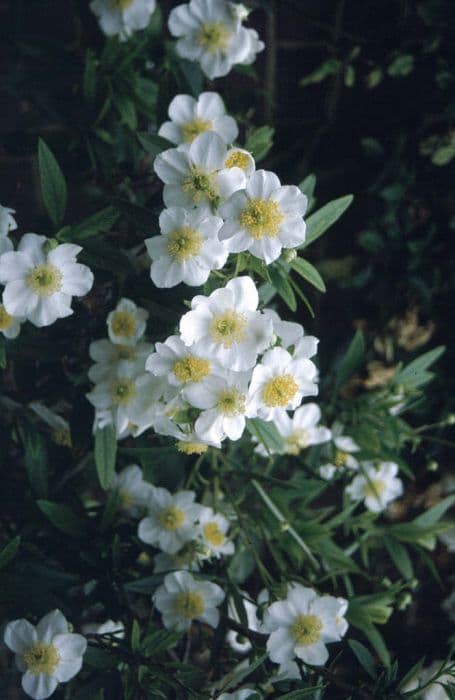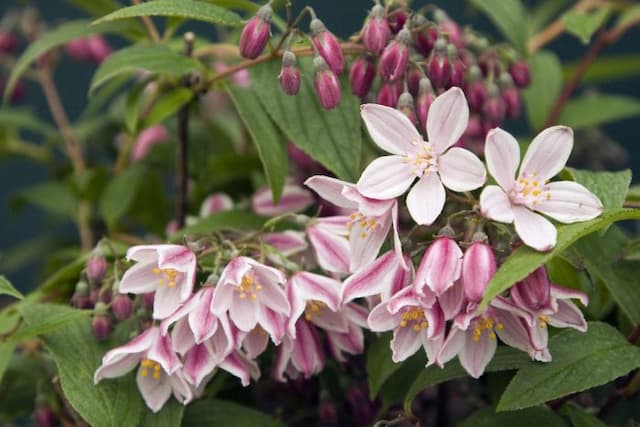Mock Orange Philadelphus 'Erectus'

ABOUT
Philadelphus 'Erectus', commonly known as the Mock Orange, is a deciduous shrub that is well-loved for its delightful fragrance and visual appeal. The plant typically has a bushy, upright form, giving it a graceful and somewhat structural look in the garden landscape, although these structural aspects are not tied to its dimensions. The leaves of Mock Orange are oval-shaped with pointed tips and have serrated edges. They are a bright, matte green and provide a lovely backdrop for the blossoms. The standout feature of Mock Orange 'Erectus' is its flowers. The blooms are creamy white and have a beautifully rich, sweet scent that can fill the air, especially on warm evenings. Each flower has four petals that are arranged in a cross shape, creating a simple yet elegant appearance. The clusters of flowers can be found adorning the branches, and as they bloom in late spring to early summer, they turn the shrub into a focal point of natural beauty. The plant's multi-stemmed habit can create a fountain of foliage and flowers when in full bloom, although specific details about its growth habit or the spread of its branches are not mentioned. The bark on older stems has a slightly peeling nature, adding texture and interest to the garden, even in the winter months when the leaves have fallen. Overall, Mock Orange 'Erectus' is a charming addition to any landscape, prized for its sweet-smelling flowers and year-round interest.
About this plant
 Names
NamesFamily
Hydrangeaceae
Synonyms
Mock Orange, Erect Mock Orange
Common names
Philadelphus 'Erectus'.
 Toxicity
ToxicityTo humans
Mock orange, including the cultivar Philadelphus 'Erectus', is not known to be toxic to humans. They are generally considered safe and there are no well-documented cases of poisoning or adverse symptoms associated with ingesting parts of this plant.
To pets
Mock orange, including the cultivar Philadelphus 'Erectus', is not known to be toxic to pets. It is typically not associated with causing poisoning in animals, and there should not be expected symptoms of toxicity if they ingest parts of this plant. However, it is always prudent to monitor pets for any unusual reactions if they consume plant material and to prevent them from eating large quantities of any non-food plants.
 Characteristics
CharacteristicsLife cycle
Perennials
Foliage type
Deciduous
Color of leaves
Green
Flower color
White
Height
5 feet (1.5 meters)
Spread
4 feet (1.2 meters)
Plant type
Shrub
Hardiness zones
5
Native area
Southeastern Europe
Benefits
 General Benefits
General Benefits- Ornamental Appeal: Mock Orange 'Erectus' is known for its highly decorative white flowers that are both beautiful to look at and fragrant, enhancing the aesthetics of gardens and landscapes.
- Low Maintenance: This shrub is relatively easy to care for, requiring minimal upkeep beyond occasional pruning, making it a good choice for gardeners of all skill levels.
- Drought Tolerance: Once established, Mock Orange 'Erectus' can tolerate periods of drought, reducing the need for frequent watering.
- Cold Hardiness: The plant is quite hardy in colder climates, able to withstand lower temperatures, which makes it suitable for many regions.
- Attracts Pollinators: The sweet-smelling blossoms attract bees and butterflies, which are beneficial for pollinating gardens.
- Seasonal Interest: It provides seasonal interest with its spring to summer blooms and has the potential for pleasing yellow foliage in the fall.
- Versatility: Mock Orange 'Erectus' can be used in a variety of landscape designs, including foundation plantings, as a specimen plant, or as part of hedgerows and borders.
- Fast Growth: It typically has a rapid growth rate which allows for quick establishment and filling in of garden spaces.
- Screening: Due to its erect and bushy nature, it can be used to create privacy screens or to hide unsightly areas in a landscape.
 Medical Properties
Medical PropertiesThis plant is not used for medical purposes.
 Air-purifying Qualities
Air-purifying QualitiesThis plant is not specifically known for air purifying qualities.
 Other Uses
Other Uses- Mock orange branches can be used for basket weaving due to their flexibility and strength when pruned appropriately.
- The wood of mock orange is suitable for making small handcrafted items like tool handles or carved ornaments because of its fine grain and ability to polish well.
- Dried mock orange flowers can be incorporated into potpourris for their fragrance, adding a fresh, citrus-like aroma to the mixture.
- The shrub can be used as a natural fence or screen for privacy in gardens due to its dense growth habit when planted in a row.
- Mock orange petals can be used to create a natural dye for fabrics in shades of green or yellow, depending on the mordant used.
- The strong structure of mock orange makes it ideal for creating living arches or pergolas when trained over a supporting structure.
- Insect-attracting qualities of mock orange make it a beneficial plant for gardeners aiming to encourage pollinators like bees and butterflies.
- Mock orange's dense foliage can provide a nesting habitat for small birds, offering them protection from predators.
- Photographers and painters may use mock orange as a subject for their art due to its beautiful blooms and aesthetically pleasing structure.
- The fragrance of the mock orange can be captured in perfumery, offering a natural, floral note to fragrance blends.
Interesting Facts
 Feng Shui
Feng ShuiMock Orange is not used in Feng Shui practice.
 Zodiac Sign Compitability
Zodiac Sign CompitabilityMock Orange is not used in astrology practice.
 Plant Symbolism
Plant Symbolism- Innocence: The Mock Orange (Philadelphus 'Erectus') is often associated with purity and innocence due to its pristine white flowers.
- Purity: White flowers like those of the Mock Orange traditionally symbolize cleanliness and moral integrity, reflecting its pure and aromatic blossoms.
- Renewal: As the Mock Orange blooms in spring, it signifies new beginnings and the fresh start associated with this season.
- Brotherly love: The genus name Philadelphus is derived from Greek words ‘philos’ meaning love and ‘adelphos’ meaning brother, suggesting a connection with fraternal affection or love among kin.
- Remembrance: The Mock Orange's distinct fragrance makes it memorable, often symbolizing a connection with past memories and moments cherished.
 Water
WaterFor the Mock Orange (Philadelphus 'Erectus'), it is important to water deeply to encourage root growth, especially during its first growing season. Water the plant with approximately 1 inch of water once a week, adjusting for rainfall. During hot, dry spells, you may need to water twice a week. Established plants will have some drought tolerance; however, they will thrive with consistent moisture. It's best to apply water directly to the soil around the plant rather than overhead watering to minimize leaf wetness and potential disease. Use mulch around the base to help retain moisture and reduce the need for frequent watering.
 Light
LightThe Mock Orange prefers full sun to light shade. It thrives best in a spot where it receives at least six hours of direct sunlight daily. However, a location with some afternoon shade can help protect the plant in regions where the sun is particularly intense, ensuring that the plant doesn't get scorched during the hottest part of the day.
 Temperature
TemperatureMock Orange is hardy and can tolerate a wide temperature range but performs best in temperatures between 60°F and 75°F. It can typically handle cold down to about -10°F but should be protected from abrupt temperature drops and frost. Ideal growing conditions include spring and fall temperatures that are moderately cool, which helps the plant to establish itself and produce bountiful blooms.
 Pruning
PruningPrune your Mock Orange immediately after it finishes blooming, as it blooms on old wood from the previous season. Pruning helps to maintain the shape, encourage bushier growth, and rejuvenate the plant, resulting in more blooms the following year. Remove any dead or damaged branches and thin out older stems to allow light into the center of the plant.
 Cleaning
CleaningAs needed
 Soil
SoilThe Mock Orange (Philadelphus 'Erectus') thrives in well-drained, fertile soil with a slightly acidic to neutral pH between 6.5 and 7.5. A balanced mix can be achieved by combining garden soil, compost, peat moss or leaf mold, and some sand to enhance drainage. Mulching helps maintain moisture and improve soil quality over time.
 Repotting
RepottingMock Orange (Philadelphus 'Erectus') typically does not require frequent repotting and is usually planted directly into the landscape. In a garden setting, it is not repotted but may be transplanted if necessary. If grown in a large container, consider repotting every 3 to 4 years to refresh the soil.
 Humidity & Misting
Humidity & MistingMock Orange (Philadelphus 'Erectus') is adaptable and does well in average outdoor humidity conditions. It does not have specific humidity requirements, so it thrives in the natural outdoor range, which is ideal for this plant.
 Suitable locations
Suitable locationsIndoor
Ensure bright indirect light and room to grow.
Outdoor
Plant in sun-part shade, moist well-drained soil.
Hardiness zone
4-8 USDA
 Life cycle
Life cyclePhiladelphus 'Erectus', commonly known as Mock Orange, begins its life cycle with seed germination in the spring, following a period of cold stratification to break dormancy. The seedlings rapidly develop into young plants with characteristic foliage. As the plant matures, usually after two to three years, it produces vigorous stems and abundant leaf growth. Upon reaching maturity, typically in late spring to early summer, Mock Orange reveals its fragrant, white flowers which are important for attracting pollinators. After the flowering period, the plant sets seed, encased in a small fruit that may be dispersed by wind or wildlife. Finally, the plant enters a period of dormancy in the fall, where growth slows and the plant conserves energy until the next growing season.
 Propogation
PropogationPropogation time
Spring-Early Summer
The most popular method of propagating the Mock Orange (Philadelphus 'Erectus') is through softwood cuttings. This technique is typically carried out in late spring or early summer when new growth is still flexible. Gardeners should select healthy stems that have not yet flowered and cut segments about 4 to 6 inches (approximately 10 to 15 centimeters) long. Each cutting should have several leaves, and the lower leaves must be removed. The cut end can be dipped in rooting hormone to encourage root development and then placed in a moist, well-draining potting mix. High humidity is maintained around the cuttings, often with the use of a plastic cover, until roots have formed, which generally takes several weeks. Once rooted, the cuttings can be transplanted to a more permanent location in the garden.






![Hydrangea [Strong Annabelle]](/_next/image?url=https%3A%2F%2Fplants-admin.emdemapps.com%2Fimages%2Fplants%2F%2Fimages%2F604b54db37d34.png&w=640&q=75)


